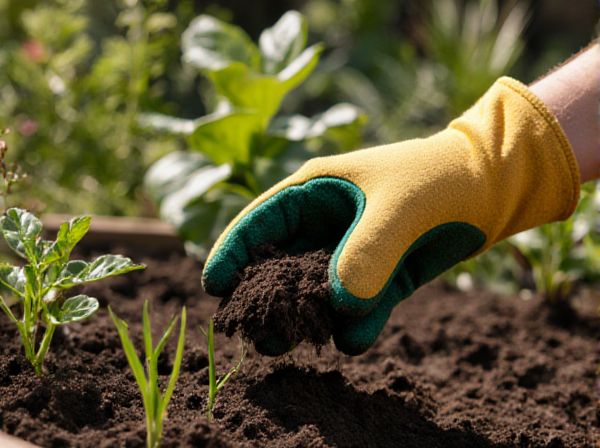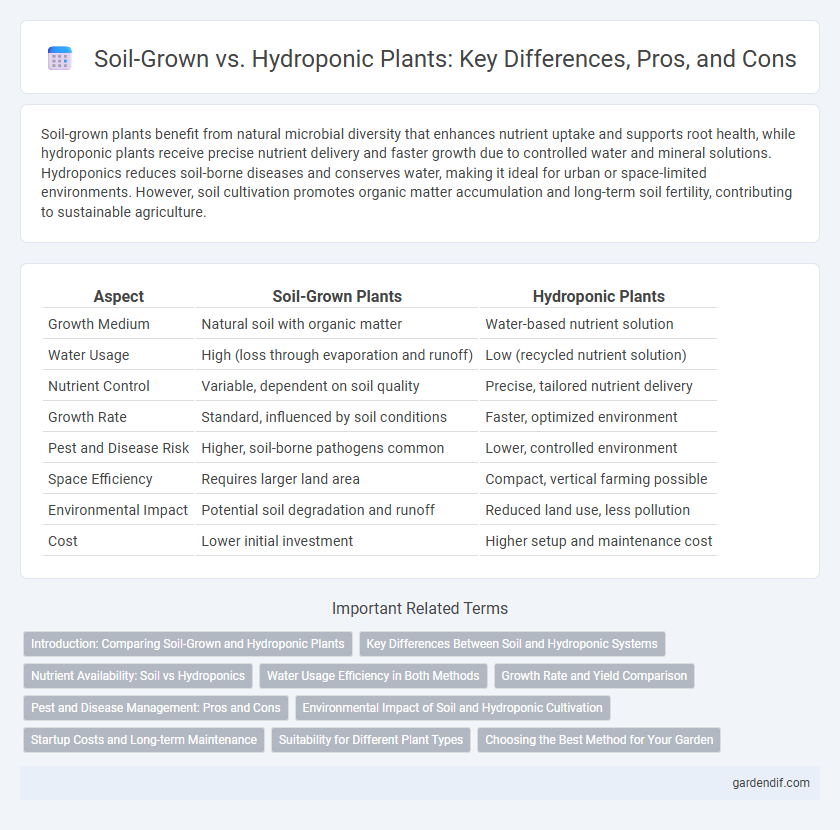
Soil-grown vs hydroponic Illustration
Soil-grown plants benefit from natural microbial diversity that enhances nutrient uptake and supports root health, while hydroponic plants receive precise nutrient delivery and faster growth due to controlled water and mineral solutions. Hydroponics reduces soil-borne diseases and conserves water, making it ideal for urban or space-limited environments. However, soil cultivation promotes organic matter accumulation and long-term soil fertility, contributing to sustainable agriculture.
Table of Comparison
| Aspect | Soil-Grown Plants | Hydroponic Plants |
|---|---|---|
| Growth Medium | Natural soil with organic matter | Water-based nutrient solution |
| Water Usage | High (loss through evaporation and runoff) | Low (recycled nutrient solution) |
| Nutrient Control | Variable, dependent on soil quality | Precise, tailored nutrient delivery |
| Growth Rate | Standard, influenced by soil conditions | Faster, optimized environment |
| Pest and Disease Risk | Higher, soil-borne pathogens common | Lower, controlled environment |
| Space Efficiency | Requires larger land area | Compact, vertical farming possible |
| Environmental Impact | Potential soil degradation and runoff | Reduced land use, less pollution |
| Cost | Lower initial investment | Higher setup and maintenance cost |
Introduction: Comparing Soil-Grown and Hydroponic Plants
Soil-grown plants develop roots within natural earth rich in organic matter, offering nutrients and microbial diversity essential for plant health. Hydroponic plants grow in nutrient-enriched water solutions, enabling precise control over mineral absorption and faster growth rates. Understanding these cultivation methods highlights their impact on plant yield, resource efficiency, and environmental sustainability.
Key Differences Between Soil and Hydroponic Systems
Soil-grown plants develop in a natural medium rich with organic matter, benefiting from microbial activity and nutrient diversity, while hydroponic systems use nutrient-rich water solutions that precisely control nutrient delivery and pH levels. Hydroponics typically enables faster growth rates, higher yields, and reduced water usage compared to traditional soil cultivation. Disease management differs as soil presents risks of pathogens inherent in the medium, whereas hydroponic setups require rigorous water monitoring to prevent root diseases.
Nutrient Availability: Soil vs Hydroponics
Soil-grown plants access nutrients through complex interactions between soil minerals, organic matter, and microbial activity, providing a natural buffer that regulates nutrient release and availability. Hydroponic systems deliver precise, readily available nutrients directly to plant roots via a controlled aqueous solution, enhancing nutrient uptake efficiency and reducing deficiency risks. While soil offers gradual nutrient release and diverse micronutrients, hydroponics allows for tailored nutrient formulations, optimizing growth conditions and minimizing environmental variability.
Water Usage Efficiency in Both Methods
Soil-grown plants typically require more water due to evaporation and runoff, resulting in lower water usage efficiency compared to hydroponic systems. Hydroponic methods recycle water within a closed system, reducing water consumption by up to 90% compared to traditional soil cultivation. This efficient water management in hydroponics supports sustainable agriculture in water-scarce environments.
Growth Rate and Yield Comparison
Soil-grown plants typically exhibit slower growth rates due to nutrient uptake limitations and environmental variability, while hydroponic systems provide controlled nutrient delivery, resulting in up to 25-50% faster growth. Yield from hydroponic cultivation can surpass traditional soil farming by 20-30%, attributed to optimized water use and nutrient balance. Hydroponics also reduces soil-borne diseases, further enhancing plant productivity and consistency.
Pest and Disease Management: Pros and Cons
Soil-grown plants benefit from a natural microbial ecosystem that can suppress certain soil-borne pests and diseases, yet they are more vulnerable to root rot and nematodes due to pathogen presence in the soil. Hydroponic systems offer a controlled environment reducing soil-borne pathogens and pests, but they are susceptible to rapid disease spread through water, such as Pythium root rot, requiring rigorous water sanitation protocols. Effective pest and disease management in both systems hinges on monitoring, preventative measures, and tailored treatments like biological controls in soil or sterilization methods in hydroponics.
Environmental Impact of Soil and Hydroponic Cultivation
Soil-grown cultivation relies on natural ecosystems and nutrient cycles but often requires significant land use and water consumption, leading to potential soil degradation and runoff pollution. Hydroponic systems use up to 90% less water than traditional soil methods and enable precise nutrient management, reducing fertilizer runoff and environmental contamination. Despite higher energy demands for indoor hydroponics, the overall environmental footprint is often lower due to efficient resource use and reduced land impact.
Startup Costs and Long-term Maintenance
Soil-grown plants require lower startup costs due to minimal equipment needs, relying primarily on quality soil and traditional tools. Hydroponic systems demand higher initial investment for pumps, reservoirs, and nutrient solutions but offer precise control over plant nutrition. Long-term maintenance in soil involves regular soil amendment and pest control, while hydroponics necessitates constant monitoring of pH, nutrient levels, and system cleanliness to prevent root diseases.
Suitability for Different Plant Types
Soil-grown plants excel in supporting root vegetables like carrots and potatoes due to the natural soil structure providing essential nutrients and adequate space for root expansion. Hydroponic systems are particularly suitable for leafy greens and herbs, offering precise control over nutrient delivery and water availability that accelerates growth cycles. Fruit-bearing plants such as tomatoes and peppers thrive in hydroponic setups where environmental factors can be optimized to maximize yield and reduce pest exposure.
Choosing the Best Method for Your Garden
Soil-grown plants benefit from natural nutrients and microbial activity, promoting robust root development and organic growth. Hydroponic systems offer precise control over water, nutrients, and pH levels, enabling faster growth cycles and higher yields in smaller spaces. Selecting between soil-grown and hydroponic methods depends on your garden's size, desired crop types, resource availability, and maintenance preferences.
Soil-grown vs hydroponic Infographic

 gardendif.com
gardendif.com